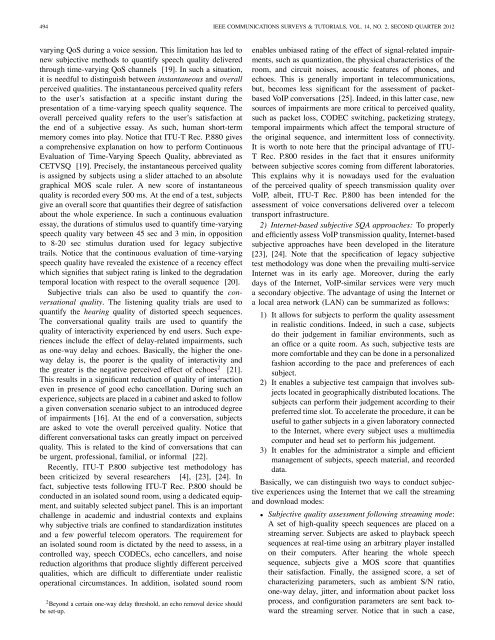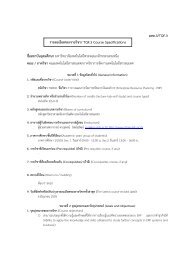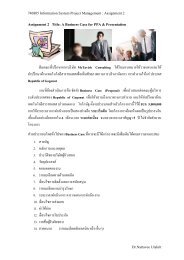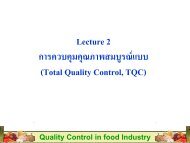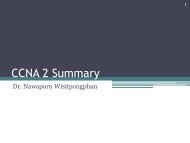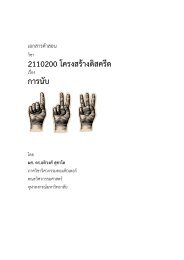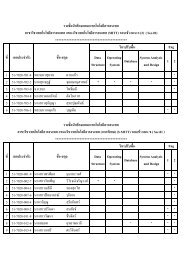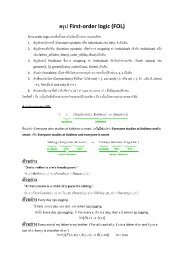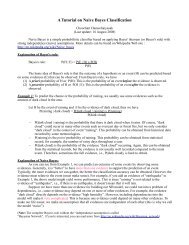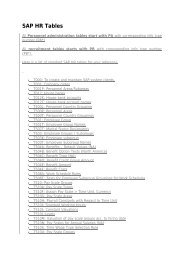Quality of Experience of VoIP Service: A Survey of ... - IEEE Xplore
Quality of Experience of VoIP Service: A Survey of ... - IEEE Xplore
Quality of Experience of VoIP Service: A Survey of ... - IEEE Xplore
You also want an ePaper? Increase the reach of your titles
YUMPU automatically turns print PDFs into web optimized ePapers that Google loves.
494 <strong>IEEE</strong> COMMUNICATIONS SURVEYS & TUTORIALS, VOL. 14, NO. 2, SECOND QUARTER 2012varying QoS during a voice session. This limitation has led tonew subjective methods to quantify speech quality deliveredthrough time-varying QoS channels [19]. In such a situation,it is needful to distinguish between instantaneous and overallperceived qualities. The instantaneous perceived quality refersto the user’s satisfaction at a specific instant during thepresentation <strong>of</strong> a time-varying speech quality sequence. Theoverall perceived quality refers to the user’s satisfaction atthe end <strong>of</strong> a subjective essay. As such, human short-termmemory comes into play. Notice that ITU-T Rec. P.880 givesa comprehensive explanation on how to perform ContinuousEvaluation <strong>of</strong> Time-Varying Speech <strong>Quality</strong>, abbreviated asCETVSQ [19]. Precisely, the instantaneous perceived qualityis assigned by subjects using a slider attached to an absolutegraphical MOS scale ruler. A new score <strong>of</strong> instantaneousquality is recorded every 500 ms. At the end <strong>of</strong> a test, subjectsgive an overall score that quantifies their degree <strong>of</strong> satisfactionabout the whole experience. In such a continuous evaluationessay, the durations <strong>of</strong> stimulus used to quantify time-varyingspeech quality vary between 45 sec and 3 min, in oppositionto 8-20 sec stimulus duration used for legacy subjectivetrails. Notice that the continuous evaluation <strong>of</strong> time-varyingspeech quality have revealed the existence <strong>of</strong> a recency effectwhich signifies that subject rating is linked to the degradationtemporal location with respect to the overall sequence [20].Subjective trials can also be used to quantify the conversationalquality. The listening quality trials are used toquantify the hearing quality <strong>of</strong> distorted speech sequences.The conversational quality trails are used to quantify thequality <strong>of</strong> interactivity experienced by end users. Such experiencesinclude the effect <strong>of</strong> delay-related impairments, suchas one-way delay and echoes. Basically, the higher the onewaydelay is, the poorer is the quality <strong>of</strong> interactivity andthe greater is the negative perceived effect <strong>of</strong> echoes 2 [21].This results in a significant reduction <strong>of</strong> quality <strong>of</strong> interactioneven in presence <strong>of</strong> good echo cancellation. During such anexperience, subjects are placed in a cabinet and asked to followa given conversation scenario subject to an introduced degree<strong>of</strong> impairments [16]. At the end <strong>of</strong> a conversation, subjectsare asked to vote the overall perceived quality. Notice thatdifferent conversational tasks can greatly impact on perceivedquality. This is related to the kind <strong>of</strong> conversations that canbe urgent, pr<strong>of</strong>essional, familial, or informal [22].Recently, ITU-T P.800 subjective test methodology hasbeen criticized by several researchers [4], [23], [24]. Infact, subjective tests following ITU-T Rec. P.800 should beconducted in an isolated sound room, using a dedicated equipment,and suitably selected subject panel. This is an importantchallenge in academic and industrial contexts and explainswhy subjective trials are confined to standardization institutesand a few powerful telecom operators. The requirement foran isolated sound room is dictated by the need to assess, in acontrolled way, speech CODECs, echo cancellers, and noisereduction algorithms that produce slightly different perceivedqualities, which are difficult to differentiate under realisticoperational circumstances. In addition, isolated sound room2 Beyond a certain one-way delay threshold, an echo removal device shouldbe set-up.enables unbiased rating <strong>of</strong> the effect <strong>of</strong> signal-related impairments,such as quantization, the physical characteristics <strong>of</strong> theroom, and circuit noises, acoustic features <strong>of</strong> phones, andechoes. This is generally important in telecommunications,but, becomes less significant for the assessment <strong>of</strong> packetbased<strong>VoIP</strong> conversations [25]. Indeed, in this latter case, newsources <strong>of</strong> impairments are more critical to perceived quality,such as packet loss, CODEC switching, packetizing strategy,temporal impairments which affect the temporal structure <strong>of</strong>the original sequence, and intermittent loss <strong>of</strong> connectivity.It is worth to note here that the principal advantage <strong>of</strong> ITU-T Rec. P.800 resides in the fact that it ensures uniformitybetween subjective scores coming from different laboratories.This explains why it is nowadays used for the evaluation<strong>of</strong> the perceived quality <strong>of</strong> speech transmission quality over<strong>VoIP</strong>, albeit, ITU-T Rec. P.800 has been intended for theassessment <strong>of</strong> voice conversations delivered over a telecomtransport infrastructure.2) Internet-based subjective SQA approaches: To properlyand efficiently assess <strong>VoIP</strong> transmission quality, Internet-basedsubjective approaches have been developed in the literature[23], [24]. Note that the specification <strong>of</strong> legacy subjectivetest methodology was done when the prevailing multi-serviceInternet was in its early age. Moreover, during the earlydays <strong>of</strong> the Internet, <strong>VoIP</strong>-similar services were very mucha secondary objective. The advantage <strong>of</strong> using the Internet ora local area network (LAN) can be summarized as follows:1) It allows for subjects to perform the quality assessmentin realistic conditions. Indeed, in such a case, subjectsdo their judgement in familiar environments, such asan <strong>of</strong>fice or a quite room. As such, subjective tests aremore comfortable and they can be done in a personalizedfashion according to the pace and preferences <strong>of</strong> eachsubject.2) It enables a subjective test campaign that involves subjectslocated in geographically distributed locations. Thesubjects can perform their judgement according to theirpreferred time slot. To accelerate the procedure, it can beuseful to gather subjects in a given laboratory connectedto the Internet, where every subject uses a multimediacomputer and head set to perform his judgement.3) It enables for the administrator a simple and efficientmanagement <strong>of</strong> subjects, speech material, and recordeddata.Basically, we can distinguish two ways to conduct subjectiveexperiences using the Internet that we call the streamingand download modes:• Subjective quality assessment following streaming mode:A set <strong>of</strong> high-quality speech sequences are placed on astreaming server. Subjects are asked to playback speechsequences at real-time using an arbitrary player installedon their computers. After hearing the whole speechsequence, subjects give a MOS score that quantifiestheir satisfaction. Finally, the assigned score, a set <strong>of</strong>characterizing parameters, such as ambient S/N ratio,one-way delay, jitter, and information about packet lossprocess, and configuration parameters are sent back towardthe streaming server. Notice that in such a case,


